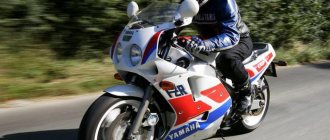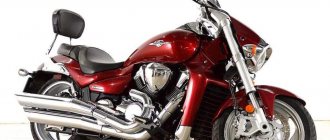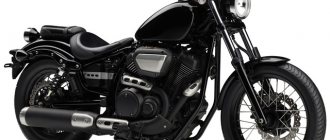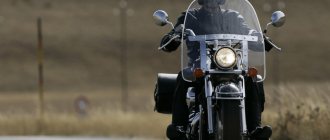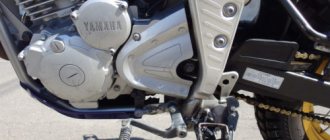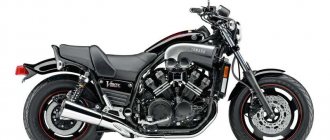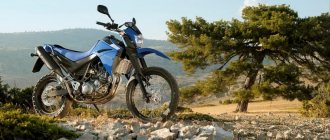YZF-R6
- motorcycle model, Yamaha brand,
The Yamaha R6 (YZF-R6) sports motorcycle model appeared on the market in 1998 (1999 model year) as a successor to the Yamaha YZF600R Thundercat (which was also produced at the same time, but positioned itself as a sport-tourist) and as a junior version of the Yamaha R1 model ( YZF-R1).
The basis was a new engine with a volume of about 600 cm³, liquid cooling, producing up to 120 hp. Compared to the Thundercat, the engine has become shorter stroke, has forged pistons with a low coefficient of friction, a new crankshaft, connecting rods, ignition system, two-pin spark plugs and Mikuni carburetors with a throttle position sensor.
In 2001, the Yamaha R6 engine received minor changes that affected the connecting rods, pistons, exhaust system, ignition system and battery (a slightly lighter one with a smaller capacity began to be installed).
In 2003, the model underwent its first major restyling. The appearance of the plastic and the headlight changes, the wheels become 5-beam. The updated model receives an injector instead of a carburetor, which led to a noticeable increase in traction in the low and medium speed zone, although the maximum power remained at the same level - 120 hp. New generation of Deltabox frame. Curb weight is reduced by 6 kg.
In 2005, the Yamaha YZF-R6 model is changing again. The motorcycle is equipped with a 41 mm inverted fork and radial calipers, the diameter of the front brake discs increases: 298 → 310 mm. As for the engine, the model receives modified intake and exhaust systems (the diameter of the exhaust manifold has been increased to 40 mm). The front tire size changes: 120/60ZR17 (55W) → 120/70ZR17 M/C (58W).
A year later, in 2006, the Yamaha YZF-R6 undergoes another major restyling. The appearance of the plastic, headlights and exhaust system changes. The model receives a new engine with inertial supercharging, producing up to 127 hp. (122 hp - naturally aspirated). The fuel tank capacity increases: 17.0 → 17.5 l. The model also receives an electronic throttle (YCC-T - Yamaha Chip Controlled Throttle) and an injection system with dual injectors (Mikuni 40EIS → Mikuni 41EIDW). The gearbox ratios change, the clutch gets a slip function. The motorcycle gets a new ignition system (DC CDI → TCI). The engine receives titanium valves, lightweight forged pistons, a titanium exhaust system with EXUP valves, and a lightweight flywheel.
In 2008, the model changes again, although visually it is very similar to the previous generation. The fuel tank capacity decreases slightly: 17.5 → 17.3 l. The engine increases the compression ratio: 12.8 → 13.1. Maximum power increases to 129 hp. (with inertial supercharging). The model receives a system with automatically variable intake manifold length - YCC-I (Yamaha Chip Controlled Intake).
2010 was marked by another small restyling of the Yamaha YZF-R6 model. The model receives an updated appearance, a new engine management program and a new exhaust. Curb weight is 189 kg. Maximum engine power is 123.8 hp.
For 2021, the motorcycle changes again, taking on the visual cues of the new Yamaha R1. The model is equipped with a 43 mm inverted fork, a new rear shock absorber, a new braking system (increased to 320 mm brake discs, ABS), an aluminum fuel tank, a magnesium subframe and a new aerodynamic system (reduces air resistance by 8%). New electronic systems have appeared: TCS (Traction Control System) and D-Mode (Selectable Drive Mode). Maximum power is 118.4 hp. Curb weight - 190 kg.
Brief history of the model
1999 - start of production and sales. First generation. Model: Yamaha YZF-R6 (Europe, North America, Australia). Factory designation: 5GV1, 5GV2, 5GV3, 5EB1, 5EB2, 5EB3.
2000 - no significant changes. Model: Yamaha YZF-R6 (Europe, North America, Australia). Factory designation: 5GV4, 5GV5, 5GV6, 5EB5, 5EB6, 5EB7, 5EB8.
2001 - minor changes to the model (described in detail at the beginning of the review). Model: Yamaha YZF-R6 (Europe, North America, Australia). Factory designation: 5MT1, 5MT2, 5MT3, 5MT4, 5MT6, 5MT7, 5MT8, 5MT9, 5MTA.
2002 - no significant changes. Model: Yamaha YZF-R6 (Europe, North America, Australia). Factory designation: 5MTB, 5MTC, 5MTD, 5MTE, 5MTF, 5MTG, 5MTH.
2003 - restyling of the model. Second generation. Model: Yamaha YZF-R6 (Europe, North America, South Africa, Australia). Factory designation: 5SL1, 5SL2, 5SL3, 5SL4, 5SL5, 5SL7, 5SL8, 5SL9.
2004 - no significant changes. Model: Yamaha YZF-R6 (Europe, North America, South Africa, Australia). Factory designation: 55SLB, 5SLC, 5SLD, 5SLE, 5SLF, 5SLH, 5SLJ.
2005 - restyling of the model. Third generation. Model: Yamaha YZF-R6 (Europe, North America, Japan, Australia). Factory designation: 5SLS, 5SLR, 5SLW, 5SLV, 5SLX, 5SLN, 5SLM, 5SLP, 5SLT, 5SLU.
2006 - restyling of the model. Fourth generation. Model: Yamaha YZF-R6 (Europe, North America, Japan, Australia). Factory designation: 4P61, 4P62, 4P63, 2C01, 2C02, 2C03, 2C05, 2C06, 2C07, 2C08, 2C09, 2C0A.
2007 - no significant changes. Model: Yamaha YZF-R6 (Europe, North America, Japan, Australia). Factory designation: 4P64, 4P65, 4P66, 2C0B, 2C0C, 2C0D, 2C0F, 2C0G, 2C0H.
2008 - restyling of the model. Fifth generation. Model: Yamaha YZF-R6 (Europe, North America, Japan, Australia). Factory designation: 4P68, 4P69, 13S1, 13S2, 13S4, 13S5, 13S6, 13S8, 13S9, 13SA.
2009 - no significant changes. Model: Yamaha YZF-R6 (Europe, North America, Japan, Australia). Factory designation: 4P6A, 4P6B, 4P6C, 13SB, 13SC, 13SH, 13SJ, 13SK, 13SG, 13SM.
2010 - restyling of the model. Sixth generation. Model: Yamaha YZF-R6 (Europe, North America, Japan, Australia). Factory designation: 13SL, 13SR, 13SS, 13ST, 13SU.
2011 - no significant changes. Model: Yamaha YZF-R6 (Europe, North America, Japan, Australia). Factory designation: 13SV, 1JS5, 1JS1, 1JS6, 1JS2, 1JS7, 1JS3, 1JS8.
2012 - no significant changes. Model: Yamaha YZF-R6 (Europe, North America, Australia). Factory designation: 1JSL, 1JSG, 1JSP, 1JSR, 1JSD, 1JSA, 1JSE, 1JSB, 1JSS, 1JSF, 1JSC, 1JSL.
2013 - no significant changes. Model: Yamaha YZF-R6 (Europe, North America, Australia). Factory designation: 1JSU, 1JSV, 2CX1, 2CX2, 2CX3.
2014 - no significant changes. Model: Yamaha YZF-R6 (Europe, North America, Australia). Factory designation: 2CXB, 2CX4, 2CX9, 2CX7, 2CX8.
2015 - no significant changes. Model: Yamaha YZF-R6 (Europe, North America, Australia). Factory designation: 2CXE, 2CXL, 2CXJ, 2CXK.
2016 - no significant changes. Model: Yamaha YZF-R6 (Europe, North America, Japan, Australia). Factory designation: 1JSY, 2CXM, 2CXY, 2CXU, 2CXW, 2CXX, 2CXS, 2CXT.
2017 - restyling of the model. Seventh generation. Model: Yamaha YZF-R6 (Europe, North America, Australia). Factory designation: BN64, BN63, BN61, BN62.
2018 - no significant changes. Model: Yamaha YZF-R6 (Europe, North America, Japan, Australia). Factory designation BN6A, BN6D
2019 - no significant changes. Model: Yamaha YZF-R6 (Europe, North America, Australia, Japan).
2020 - no significant changes. Model: Yamaha YZF-R6 (Europe, North America, Australia, Japan).
2021 - no significant changes. Model: Yamaha YZF-R6 (Europe, North America, Australia, Japan).
Supporters, regimes, systems
Also, which auxiliary bodies control the plant. We have, of course, variable and traction control maps. The thrust has 6 muzzles. The highest forces us not to go crazy, and any too ambitious jerk of the handle will end with a blinking indicator and a fig with a poppy. The closer to one, the more you can do with the motorcycle. Take a little more, like a circle, or leave a trail of asphalt without heating. Overlays on white are also an option. Of course, you can also turn off the traction completely and then, with the highest card, you have everything the manufacturer gave you at your disposal. Therefore the recommended reason.
We have 3 modes. Standard, sporty and depressed. Changing the mode not only shows a different desire to drive the car, but also how much you need to turn the knob to get the wild boost effect. In other words, in the weakest mode you spin hard and accelerate smoothly and slowly, while in sport mode... subtle hand movements make a big difference. Therefore, this mode is more suitable for track. On average, this is useful because every gentle movement of the phone is a little tug. The road is inconvenient. Very out of place when driving with a passenger. And the difference between the individual modes, believe me, is very noticeable. These are not subtle changes, but something that immediately catches your eye.
Sport bike Yamaha YZF-R6
You can change the program and thrusts while driving, but only when engine braking. You won't be able to do anything while speeding up. Complete shutdown, if I remember correctly, is only possible when the motorcycle is stopped, if you hold the gear shift mode key longer.
Specifications:
| Model | Yamaha R6 (YZF-R6) |
| Motorcycle type | Sport |
| Year of issue | 2016 |
| engine's type | 4-cylinder, 4-stroke, in-line |
| Working volume | 599 cc cm. |
| Cooling | Liquid |
| Bore/Stroke | 67 mm x 42.5 mm |
| Number of valves per cylinder | DOHC, 4 valves per cylinder |
| Fuel supply system | Injector (Microprocessor Controlled Throttle - YCC-T) |
| Maximum power | 122 hp at 14500 rpm |
| Maximum torque | 65.7 Nm at 10500 rpm |
| Transmission | 6-speed, constant mesh |
| type of drive | chain |
| Frame | aluminum |
| Front suspension | inverted fork (41 mm), travel - 115 mm |
| Rear suspension | pendulum with monoshock absorber, stroke - 120 mm |
| Front tire size | 120/70-ZR17 |
| Rear tire size | 180/55-ZR17 |
| Front brakes | Hydraulic 2-disc, diameter 310 mm, 4-piston calipers |
| Rear brakes | Hydraulic 1-disc, diameter 220 mm, 2-piston caliper |
| Acceleration 0-100 | 3.2 sec |
| Maximum speed | 277 km/h |
| Seat height | 850 mm |
| Overall dimensions (LxWxH) | 2040x705x1095 mm |
| Wheelbase | 1375 mm |
| Gas tank capacity | 17 l |
| Motorcycle weight (curb) | 189 kg |
Price for Yamaha YZF-R6 motorcycle
Today, the price of a Yamaha P6 motorcycle ranges from 12,000 to 13,000 dollars for a new motorcycle, and from 4,000 to 7,000 dollars for a used car, depending on the year of manufacture, condition and mileage.
You can see prices for new motorcycles on the manufacturer’s website at the link: https://www.yamaha-motor.ru/ru/products/motorcycles/supersport/yzf-r6.aspx.
There is a direct connection between the very first Yamaha motorcycle and the modern R6. This connection is Yamaha's dedication to the Kando tradition and unwavering design philosophy. Simple and lightweight, compact and powerful are the main criteria that guided the company when creating the YZF-R6. This machine was able to combine all the qualities necessary for lovers of fast motorcycles. And if it is not ideal, it is very close to ideal.
From music to motorcycles, for over 100 years, Yamaha has maintained its unique way of thinking, which combines ancient Japanese philosophy with human emotion, and continues to influence motorcycles and musical instruments with the Three Crossed Tuning Forks logo.
Comparative table of technical characteristics of different generations of motorcycle:
| Options | Yamaha R6 2001-2002 | Yamaha R6 2003-2004 | Yamaha R6 2005 | Yamaha R6 2006-2007 | Yamaha R6 2008-2009 | Yamaha R6 2010-2016 |
| Bore/Stroke | 65.5 x 44.5 mm | 67.0 x 42.5 mm | ||||
| Compression ratio | 12,4:1 | 12,8:1 | 13,1:1 | |||
| Maximum power | 118 hp at 13000 rpm | 121.4 hp at 13,000 rpm (with inertial supercharging) 115.3 hp. at 13000 rpm (without inertial boost) | 124.3 hp at 13,000 rpm (with inertial supercharging) 118.3 hp. at 13000 rpm (without inertial boost) | 132.2 hp at 14500 rpm (with inertial supercharging) 125.3 hp. at 14500 rpm (without inertial boost) | 133.6 hp at 14500 rpm (with inertial supercharging) 127.3 hp. at 14500 rpm (without inertial boost) | 122 hp at 14500 rpm |
| Fuel system | Keihin carburetors (37 mm) with throttle position sensor | injector | injector (with YCC-T system) | injector (with YCC-T and YCC-I systems) | ||
| Ignition | digital DC-CDI | TCI | ||||
| Gearbox, clutch, drive | 6-speed gearbox, multi-plate wet clutch, 532 chain | 6-speed transmission, multi-plate wet slipper clutch, 525 chain | ||||
| Front suspension | 43 mm telescopic fork, all adjustments, travel - 130 mm | 43 mm telescopic fork, all adjustments, travel - 120 mm | 41mm inverted telescopic fork, fully adjustable, 120mm travel | |||
| Tire size | Front: 120/60-ZR17 Rear: 180/55-ZR17 | Front: 120/70-ZR17 Rear: 180/55-ZR17 | ||||
| Curb weight | 193 kg | 188-190 kg | 192 kg | 189 kg | ||
What do we end up with?
This motorbike is one of the most frequent participants in world championships, which once again confirms its quality. It is capable of phenomenal acceleration, which leaves many competitors far behind in the first seconds. At the same time, driving such a vehicle is more than easy.
Technical innovations such as an upgraded engine and an improved chassis make this Japanese motorcycle a true king of the track - and nothing is likely to change anytime soon.
And the appearance of the model is simply amazing. Just look at the photo of the Yamaha P6 to understand that this is one of the best sports bikes . Fast, powerful, lightweight - this model has a lot of advantages.
All this is confirmed by positive reviews about the motorcycle. As a result, the model is suitable for all sports bike lovers. It is worth noting that the model is not just made in a sporty style, but is designed specifically for racing - in the city the suspension behaves somewhat harshly. But on the track there is simply no equal to this bike.
Video review of the Yamaha R6 motorbike:
Why are these “six hundred” cars needed at all?
Even if for the most trivial reason: you need to know how to handle a 200-horsepower “liter.” Yes, the potential contained in it pleasantly tickles the vanity and sometimes frees you from the need to frantically go through gears. But, believe me, sometimes there are too many “horses”. Especially when you have already learned how to unscrew the throttle on a straight line, but have not yet learned how to turn and stop. So the “mid-sized bike” is a necessary (I would add, vital) stage in the sportbike evolution, which is not at all a shame to linger on. After all, no other type of single-track vehicle is capable of being so responsive, sharp and fast in turns. And the ER-6 also accompanies its exploits with a heartbreaking, piercing soundtrack of an engine screaming at 16,000 rpm. Just the moan that is called a song.
0
For the fact that Yamaha did not follow the lead of fashion and left the classic combination of a huge saucer dial tachometer and a digital panel, I would like to say a special thank you! Even if they just used a warehouse of old spare parts. After all, similar devices have already been found on the YZF-R1 of the 2012 model.
There is no doubt that everything that “supersport” is criticized for – lack of comfort and complete inability to adapt to the daily routine – is also present. There is nothing to savor in the Er-6 at city speeds: no fat “middle”, no “commander’s” landing... She lives on the “ring” and for the sake of it. And yet, I personally do not understand the demonstrative withdrawal of most manufacturers from this niche. No, from an economic point of view, everything is logical: no sales, no motorcycles. From a practical point of view, I see a gap: switching from the puny “three hundred” straight to a “liter” is at least stupid. This means that in the foreseeable future it is the YZF-R6 that will have to take the rap in this segment for all the “Japanese”. Like the MV Agusta F3 675 - for the “Europeans”.
0
Yamaha engineers apparently decided that they didn’t seek goodness from goodness, so the frame and pendulum actually remained the same, having been adapted for the installation of an anti-lock brake system: brackets for mounting the block were added (strangely, there was a place for it only on the right outer side of the frame) and ABS sensor. The magnesium alloy subframe is slightly tapered at the seat area and configured to accommodate the new tail section.
Brakes
If something is going well, it would be good to stay on time. ABS and large shields keep an eye on him. The result is a system that is very responsive and responds perfectly to what the driver does with the handle. One finger is all you need to operate the brake. The jump is not too big, the braking is easy to feel. ABS “teeth its teeth” during operation, but its work is like running your finger over a comb. Rapid transition between the phases of inhibition and remission. You won't be able to make a nice meter out of a dozen or so meters, but the bike is probably slowing down. I don't know if it's possible to disable ABS. But the system works well.
